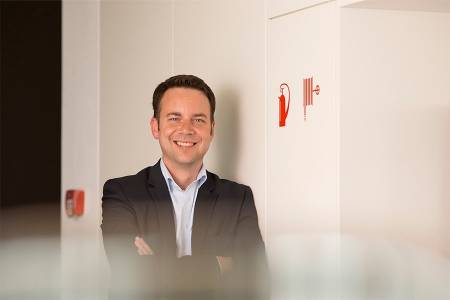His solution may not be radical, but it is remarkable: Martin Hofer is Chief Information Security Officer at PostFinance, and sets aside one day a week to look after his two children, aged four and six. However, with his 80 percent employment level, he is still the exception in Switzerland. According to the Swiss Federal Statistical Office, in 2020 a mere 20 percent of men worked part-time, while the figure for women was around 60 percent. But for Martin Hofer, when his first child was born, he knew he wanted to work part-time so that he would be able to reliably take on some of the childcare in the long term.
You are here:
How fathers go about striking a work-life balance – an interview with Martin Hofer
Martin Hofer, Chief Information Security Officer at PostFinance, has been working with an 80 percent employment level since his first child was born. In our interview with him, he explains how he manages to strike a balance between family life and working life, and where he has cut back.

Martin, how do you currently organize the childcare?
My wife has a 50 percent employment level, whereas I work 80 percent. My wife looks after the kids on two days, I look after them every Friday, and the other two days are covered by the daycare center or kindergarten.
What made you decide to go part-time? Would full-time employment not have been a more convenient solution?
I wanted to be with my children as much as possible, and I was looking for a way to strike a better balance in terms of sharing the childcare responsibilities. I don’t want to brag about my 80 percent employment level. When you compare it to my wife’s 50 percent workload, we’re still in a tricky situation. Still, it’s a solution that allows me to “run the show” once a week in my private life in the long term. In other words, I’m not just a last resort who steps in in exceptional circumstances, only to end up having to ask for help because he can’t find the kids’ shoes. My experience has taught me you need to decide what arrangement you want as a couple at the outset. After all, hardly anyone is going to switch to a more awkward arrangement later on.
You’ve been working part-time for six years now. How successfully would you say you’re balancing family and working life?
There are days where it works out better than others, days when I just don’t quite live up to my expectations, days I prioritize my employer, and days where things are different. You do have to reflect on this balance from time to time and react to indications from both sides, be it your employer or your partner. There’s no way around it. For me, it’s important that the overall arrangement works out, and that, on balance, I feel I’m successfully striking a balance between family and working life.
You set aside one day a week for your kids. What are your other workdays like?
I do frequently find myself working at ungodly hours. For instance, in the evening when the kids have gone to bed and the house is quiet again, I often find myself getting back to work. Or I may start work early in the morning. The weekends, however, I try to keep as free as possible. I don’t keep track of when I work and how much I do. I just love what I do too much for that.
Have there ever been situations where you’ve had to leave a meeting because something has come up out of the blue with your kids?
Fortunately not. I personally feel that’s only needed in absolute emergencies. But I may occasionally have to postpone a meeting in advance because it clashes with me picking up the kids, for instance. In these instances, I hope my colleagues are understanding, and very often they are – and that goes for colleagues who have kids themselves, and those who don’t. I really appreciate the culture at PostFinance in general: I’m never given funny looks or criticized for working part-time.
You work in middle management with PostFinance. To what extent are the challenges you face trying to balance working life and family life different to if you were doing an 80 percent workload at another level in the company?
The challenges are the same on all levels. Based on my experience, the challenge of an 80 percent employment level is trying to fit your full-time workload into a part-time week, which involves setting priorities. This is something you need to be able to handle, regardless of whether you’re in a management role or not.
When your first child was born, you wanted to go part-time. How did your boss at the time react?
He gave me his full support. That was a big help to me. We didn’t spend any longer than ten minutes discussing what I wanted to do, and the matter was clear.
How would you react as someone’s supervisor if they came to you with a similar request?
I generally try emulate the way my boss at the time reacted, and come up with solutions together with the team so that such working models can be implemented. Of course, this will always require some work and a certain amount of patience from the person looking to reduce their workload. We may not be able to implement the model they want overnight. But, based on my own experience, there’s always a way.
One of these solutions is job sharing or topsharing, which is something you have done already. How did this come about?
I had the opportunity to share my job with a colleague for a year. For me, this was an exciting time where I could take on the well-known challenges that job sharing and topsharing come with. The biggest of these was the fact that the people around you actually see you as a unit. When my topsharing partner at the time left PostFinance, we juggled jobs around somewhat, and I ultimately ended up with the model I started with, i.e. fitting a full-time job into an 80 percent working week. Personally, I feel this model is almost easier because you can decide what your priorities are and what sort of balance you would like.
Full time or part time for fathers: do you occasionally discuss the subject with other fathers and mothers, and if so, what comes up?
It’s a topic that always comes up in discussions, and an area where you still encounter traditional roles to a large degree. When I talk to men about the subject, we often end up discussing whether in fact a 90 percent employment level would be more suitable for financial reasons and due to late evening and early morning work. My view is clear: if I look at my overall situation and how good it actually is, I feel there’s no point even discussing this 10 percent.
You mentioned before that you can’t brag as a father with an 80 percent employment level. Or maybe you can when you consider that, currently, only about 20 percent of men in Switzerland work part-time, and they probably don’t devote all that extra time to childcare?
I personally feel it’s a shame more fathers aren’t going more in this direction. Still, at least where I work I do have a lot of colleagues who subscribe to this model or similar models, though it isn’t actually a really fast development.
How could PostFinance have an even bigger impact on these developments as an employer?
I get the impression that PostFinance has done all it can to provide a professional environment that’s conducive to a good work-life balance. In other words, I don’t personally know anyone who wanted to make adjustments and was unable to do so. The environment we have is the right one. With that said, partnerships themselves have to express the desire to reduce workloads and to take advantage of relevant models. What I think would really make a difference is to raise awareness that work models like topsharing and job sharing are not just for women. To this end, I would personally be keen to see more male duos or mixed tandems in future.
You’re committed to gender diversity in the workplace, which has even earned you a nickname.
Yes, a few years ago I was called “Martina” for a bit. I remember one management day I took the liberty of challenging the perception we do that great a job promoting women at PostFinance. I recall looking around and noticing that, aside from the HR manager, there were only men in the room, at which point I suggested the gender diversity at managerial level was perhaps not that great. Maybe it was still a bit too soon, but the discussion has come up again. Currently we’re seeing efforts to increase female representation at management level. At senior management level, we’ve actually already seen a balance struck.
In the work, family, free time triangle, what’s fallen by the wayside?
Free time. That’s where I’ve had to cut back, but it’s fine because I’m pretty easy to please in that regard. On platforms like LinkedIn in particular you always come across superhumans who claim they can easily strike a perfect balance of everything. I, on the other hand, believe you do have to make sacrifices in some areas, but of course with the hope this won’t be for good, especially when the kids have grown up and become more independent. I’m actually already getting a sense of that now.
If you could give working mothers and fathers a tip, what would it be?
It’s not worth feeling bad because of minor changes to your routine. It’s not the end of the world if you empty the dishwasher on a designated workday, and by the same token it’s not the end of the world if you pick up the phone at one point for a business call on a day you’re with the kids.
About

Martin Hofer has been Chief Information Security Officer at PostFinance since 2012.
We recognize our position as a role model, and are positioning ourselves as a responsible company. But this doesn’t just involve thinking about the environment – we also assume social responsibility as an employer. This means that – in addition to our target of achieving climate neutrality (in direct and indirect emissions) by 2040 – diversity and work-life balance are also fundamental.
